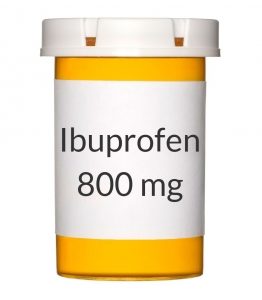How safe is ibuprofen?

Ibuprofen is under a class of medications called non-steroidal anti-inflammatories (NSAIDS). Ibuprofen is the generic name and is also sold under the brand names “Motrin” and “Advil”. Ibuprofen decreases inflammation and helps with pain and can be purchased over the counter without a prescription.
However, that does not mean the drug is entirely safe.
The maximum adult dose is 1 200 mg per day. With a 200 mg pill, that means up to 6 pills per day. That maximum dose per day relates to short term intake. With long term intake, the maximum dose should probably be lowered. Too much ibuprofen can cause kidney failure, heart failure, or even seizures. It can also thin your blood, meaning, your blood will not clot as quickly as it should. Theoretically, if you exercise regularly, the exercise will cause inflammation and microtrauma. The body then heals itself stronger than before. There is some evidence that ibuprofen will hamper this process along with increasing the risk of kidney injury, especially if one participates in very long running sessions.
The Research
Emerg Med J. 2017 Oct;34(10):637-642. doi: 10.1136/emermed-2016-206353. Epub 2017 Jul 5.
Ibuprofen versus placebo effect on acute kidney injury in ultramarathons: a randomised controlled trial.
Lipman GS1, Shea K1, Christensen M1, Phillips C2, Burns P3, Higbee R4, Koskenoja V5, Eifling K6, Krabak BJ7.
Author information
1
Department of Emergency Medicine, Stanford University School of Medicine, Stanford, California, USA.
2
Department of Computational Sciences, University of Colorado at Boulder, Boulder, Colorado, USA.
3
Emergency Medicine Residency, University of Washington, Seattle, USA.
4
Stanford-Kaiser Emergency Medicine Residency, Stanford, USA.
5
Harvard Affiliated Emergency Medicine Residency, Harvard Medical School, Boston, USA.
6
Washington University in St. Louis Emergency Medicine Residency, St. Louis, USA.
7
Department of Orthopedics and Sports Medicine, University of Washington, Seattle, USA.
Abstract
BACKGROUND:
Despite concerns that non-steroidal anti-inflammatory drugs (NSAIDs) contribute to acute kidney injury (AKI), up to 75% of ultramarathon runners ingest these during competition. The effect of NSAID on AKI incidence in ultramarathon runners is unclear.
METHODS:
Multisite randomised double-blind placebo-controlled trial in the Gobi, Atacama, Ecuador and Sri Lankan deserts to determine whether ibuprofen (400 mg every 4 hours) would be non-inferior to placebo during a 50-mile (80 km) foot race. The primary outcome was incidence of AKI defined as severity categories of ‘risk’ of injury of 1.5× baseline creatinine (Cr) or ‘injury’ as 2× Cr, combined to calculate total incidence at the finish line. Non-inferiority margin for difference in AKI rates was defined as 15%.
RESULTS:
Eighty-nine participants (47% ibuprofen and 53% placebo) were enrolled with similar demographics between groups. The overall incidence of AKI was 44%. Intent-to-treat analysis found 22 (52%) ibuprofen versus 16 (34%) placebo users developed AKI (18% difference, 95% CI -4% to 41%; OR 2.1, 95% CI 0.9 to 5.1) with a number needed to harm of 5.5. Greater severity of AKI was seen with ibuprofen compared with placebo (risk=38% vs 26%; 95% CI -9% to 34%; injury=14% vs 9%; 95% CI -10% to 21%). Slower finishers were less likely to encounter AKI (OR 0.67, 95% CI 0.47 to 0.98) and greater weight loss (-1.3%) increased AKI (OR 1.24, 95% CI 1.00 to 1.63).
CONCLUSION:
There were increased rates of AKI in those who took ibuprofen, and although not statistically inferior to placebo by a small margin, there was a number needed to harm of 5.5 people to cause 1 case of AKI. Consideration should therefore be taken before ingesting NSAID during endurance running as it could exacerbate renal injury.











